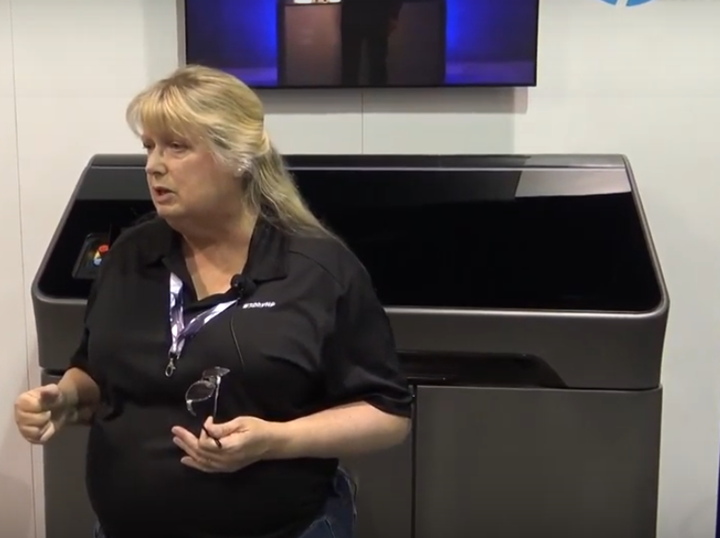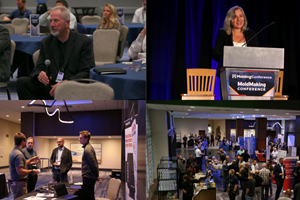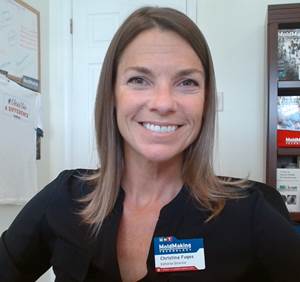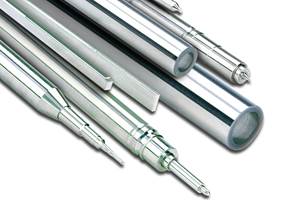VIDEO: How to Really Use a 3D Printer
Learn how color 3D applications are enabled with a 3D printing system that allows the production of functional parts in full color in a fraction of the time.

Even though we’re several months past Amerimold 2019, there is still so much to be learned from what was going on at this year’s event for mold manufacturing. That includes a demo from HP on 3D printing.
Get a look at HP’s latest 3D printer - the HP Jet Fusion 500/300 Series - designed to overcome existing color 3D printing challenges and open up innovation for small- to medium-sized product development teams and design businesses, universities and research institutions.
Learn about how color 3D applications are enabled with a 3D printing system that allows the production of functional parts in full color - with voxel control - in a fraction of the time. Watch the video or read the transcript below to find out more.
Barbara Arnold-Feret: Good afternoon. I'm Barbara from HP. I'm a field specialist for Hewlett Packard — which used to be what our name was — but now we separated about two, three years ago into two different companies. You probably are familiar with Hewlett Packard from your personal systems. Well, we're known as HP. And underneath the HP banner, we have several different divisions — several things that we do.
But we're here today to talk to you about 3D printing. 3D printing for HP is an exciting new area for us. We believe that this is the future of manufacturing. And one of the reasons that we got into 3D printing is because we want a piece of that $12 trillion manufacturing area. 3D printing represents integration, disruption, as well as the ability to make more profit. This impacts production by allowing you to get parts faster, integrate them into your manufacturing floor and do things that you couldn’t do before. As part of that portfolio of products that we offer, we're showcasing the 580 machine today.
The 580 machine is really oriented toward doing parts at around 100 pieces per week and below, for those that are you wanting to do two prototypes with jigs, fixtures, accessories, etc. and into the product mix. We're going to be talking about this machine in particular, which is the machine that does color also as part of our portfolio. At the end of the presentation, I'll be talking about the complete range of machines, including the 4200 series and the 5200 series. As well as we're going to do a little bit of a deep dive into some of the technical details. My associate, Brent, is going to come up and he's going to talk about those tech areas. And I'm going to be talking more about applications: how you really use this machine.
So first of all, let me tell you some general things about the machine. The 580 in our portfolio is an all-inclusive solution. That means that you print you clean, you do everything within this footprint of the machine. If you open up the lid you can actually see the printing area. You have a carriage that dispenses ink, as well as has a heat source. Now we're a little bit different. Multi Jet Fusion uses a heat source and actually fuses the material into a part. It's not binder jetting. It's not laser ring. It's not doing fused deposition modeling. It actually is a completely unique process called Multi Jet Fusion.
Multi Jet Fusion applies the same principle that you have when you go out on a summer day in a black t-shirt: you get hot. Well, by having an ink that attracts that heat, we actually melt that polymer down and fuse it. And because we have entanglement of molecular strands, between layers, we get a fully dense part. It's isotopic, it's fully dense without voids, and it's uniform throughout. When you look at this machine, you have three distinct areas. And we're going to get more in the technical details. But the three distinct areas you have are your print area, with your carriages for both spreading powder and for dispensing the ink or what we call the fusing agent and the detailing agent, which acts as masking tape, preventing thermal bleed into the adjacent areas.
Then you also come down to things that you're very familiar with if you've used HP products in your personal life. If you look here, you have your agent dispensing area. This is a plug-and-play aspect where you have both colors, the fusing, and the detailing agents dispensed. And on this side, you also have the materials area. Now, we haven't got the materials canister in it right now. But you have the ability to recycle the content of the materials up here that you haven't used in the build of the part into the machine itself. [The recycling feature has a] ratio of about 80% of all reusability and it mixes it right there in the machine. We also have a virgin material, the canister, and it has an internal auger that allows you to feed the material through the machine, automatically. When you have the powder plate over the build area, the carrier system will come through (and you are going to move it slowly). The carrier system comes through and dispenses the fusing and detailing agent as well as it has the heat source comes over the build area all the way to the side, and it comes back. And then the material plays through. As you fuse the part, the platform will lower. You also have the ability to make sure that there's monitoring of any hot spots or cold spots so that we can apply heat and then you'll have the differential monitor and applied the same time.
Now, where does this go in your manufacturing area? In this particular machine, it allows you to have durable prototypes. What does that mean? Well, this is a great example. If you look at this little Can you can see obviously that this has got an FEA pattern on it. But more than that—if I [throws can on ground]—it doesn’t break. So it's durable. So you can do things with this, that in a lot of your aspects that you have got prototypes being done in your plants right now, if you drop it throughout the year, you usually your user has a heart attack because they're afraid it's going to break. So this gives you a lot of options. Additionally, it lets you do intricate details in different colors. You know this little chess piece has an outer layer, but you also have the inner colored layer. So it allows you to do all these detail pieces and get your accuracy reproducibility in a durable part.
So you guys want to look at this, pass it around. Don't take it though, promise you give it back? I'm not sure I'm going to give this to you. Okay, all right. Didn't get agreement from the crowd. So we won’t pass that around; I can see that it was going to disappear.
So when you look at this machine, what does that mean for you on a manufacturing floor? That means that you get the color, you get the durability, you get the ability with the accuracy and the reproducibility in an affordable solution. HP offers you a lot of ways to get this machine and integrate it into your manufacturing. Is it going to replace injection molding? No. But should you integrate it into your factory to give you another option on those jobs that you know, on the things that you can do now easily, on things that are having a short run, and you have to store the tools forever. This gives you a lot of options. So we've got three machines that go into that. And I'm going to turn this over to Brent, he's going to talk about the technical details of the machine. And then you can ask us some questions about build ratios, accuracy, area, etc, that we've got the information here for you. Also, I want to invite you, we've got literature here that has comparisons of the different machines and our entire portfolio. As well as we talk about specific features of this machine. That includes color. That includes a smaller footprint. It includes being able to have a cost-effective solution on your manufacturing floor. So let me turn over to Brett, let him take it away.
Brent Ewald: Thank you, Barbara. Hi, everyone. I'm Brent Ewald. I'm an applications engineer based out of the Midwest. I actually used to work research and development on this printer. She already covered a lot of the basics about how this printer works: you recoat powder, you mask where you want the part, you melt it with energy. But what I'm going to talk to you about it is the science of color in our parts.
So when you think of our parts, you know these solid objects, how would you go about putting color on it? You need to absorb energy; that's the key component to our process. So a very exciting thing is our ink chemist developed was a bright fusing agent. This is an ink agent that is absorptive in the IR spectrum, and transparent in the visible spectrum. So to us, it appears to be white, or clear. And to the part or to the lamps, the energy that we‘re melting with it appears black. This is really exciting. And the way we get color from here is we use black fusing agent and then create a shell around the outside. And on that shell we apply color. At this point, we have a white piece of paper and it's just like printing 2D. We can leverage our 30 years of printing excellence to create the type of colors and parts you would expect from an HP color printer.
Now, the the other thing, though, is there's an economic aspect to it. So we kind of adopted what we term a geological model. So you have the core, the mantle, the crust. And so what we've done is we keep that core black to save everyone money, and it's a great economic design, and then you have the mantle around the outside. And then the color. The nice color you see here is just on that that outer layer. So it colors only skin-deep. Anyways, I'm going to turn it back to Barbara to talk more about the portfolio and how it exists in your manufacturing.
Barbara Arnold: So, whenever we look at the portfolio and all the things that we do at HP, one of the things about HP that you probably know about us is that we can dispense ink and liquids better than anybody else in the world. Because we've taken that 2D expertise and applied it to 3D. Now why did we decide to go into 3D printing? If you think about where HP has always been, that's been printing. We started with paper, then we went to other media that included metals, like the coke cans, and packaging. And then we went to latex went to wall coverings, we went to page white printers, we went to signage, we went to all sorts of digital printing. So it's a natural evolution that we went to 3D printing. And in fact, in our portfolio coming up very soon, we're actually adding more materials every day, both in 2D and in 3D. And more importantly, we continue to evolve. Because we're an evolutionary type of technology, it continues to improve. With asset improvement, we look at different products that fit into your manufacturing needs. And so we have a portfolio, when you look at the 5200, which is the high volume production machine, which is really meant to give you options that you couldn't enjoy otherwise, for both manufacturing tools, assembly aids production, it gives you the ability to do a whole range of products that you couldn't approach without tooling before. Then you have a 4200, which is a bridge between the prototyping to production. And then you have the 500 series, which is really aimed solidly at prototyping as well as picture.
So when you look at our entire portfolio range, what's going to be next? Well, in 2021, we're going to be printing metals. So I invite you to come back and see me in two years when you can buy a metal machine. You can buy parts right now through our website because we've partnered with two service bureau companies that allow you to get metal parts right now, as our platform evolves and gets finalized. The other thing that we're doing is we're looking at applications. 3D printing and additive manufacturing really are integrated into your entire manufacturing workflow. We want to be able to give you options that you couldn't enjoy before. Those options mean to us parts, volumes that you couldn't get at, and ability to quote product that you haven't been able to quote before.
If you'd like to have more information, please see me or see Brent; we're going to get information to you. But we also have some literature in the booth. But this is also the machine. So I'm Barbara, this is Brent.
I'm going to open it up for questions right now. And I'm going to repeat the question so that they can hear it throughout the audience. Any questions? Crickets. Come on, guys.
Audience Member: What's the material?
Barbara Arnold: The materials are nylons. In most cases, we have a 9, a 12 and 11, a nylon 12 glass speed, and the thermal plastic urethane. Now people ask me—and you guys are all in the plastic processing business—what's the difference between a thermal plastic and a thermal set? Here's a great example. If you have butter and pancakes in the morning, if you have pancakes, that's a thermal set because you can't go back and put it in the box. If you have butter, you melt it, but you can actually have a solid patty of butter again because it will transition back to a solid. So that's kind of the same difference between a thermal plastic and a thermal set. You can't put the pancake back but you can put the butter back. And you'll never forget that example will you? So any other questions?
Audience member: Do you have the eurothane?
Barbara: Yeah, we have the eurothane.
Brent: So this is the eurothane that's being asked about [holds up eurothane]. It has variable lattice structures here. And you can see different levels of, essentially, softness with the same material. So the idea behind this is you shouldn't let the material limit what you can do with it.
Barbara: Yeah, and this is a prime example of how design also affects the resiliency of the part. The thinner, the latest work on that, the more you can squish it down. The thicker, the stiffer it appears. The same thing on nylon 11, for example, which is a more flexible material that we offer, it gives you options if you want higher impact materials. 12 is kind of the bell ringer. It’s the one that's most often used and it gives you exceptional stiffness or engaging strength, impact strength, etc. Exceptional. “Does this replace injection molding” is another question I get asked; no, it absolutely doesn't. If you need to do 5 million parts in a year, you're going to want injection molded. You're going to do a million parts of year, you're going to want injection molded. If you want to do 20,000 parts a year, though, we probably need to talk, especially if you've got that spread out throughout the entire year. And we all have customers that want to come up and they want to do parts, but they only want a few at a time. This allows you to do JRT manufacturing. It allows you to avoid having to store tool. And it also allows you to quote the jobs that you couldn't quote before.
Brent: As an example of that, I would challenge you to make this impeller with less than a five-axis mill or injection molded in less than three parts.
Barbara: Yeah. Good example. And then I have a more complex impeller that was over there. It's almost impossible to mold because of the curvature of the fins. We're seeing that more and more customers want lightweight as another option. And whenever you look at this compared to aluminum, for example, in a cast part, this gives you light-weighting savings as well as impact resistance, as well as some design aspects that you couldn't have gotten any other way. It allows you do thinner parts, allows you to do latticework. Allows you to do things that you didn't think about before. In fact, we do a lot of design for additive manufacturing seminars. And what we do is we asked you to go all the way back to the concept development and get to the root cause of what you want that part to do. Then you truly develop the design for adding manufacturing parts, rather than just duplicating what you've already done and other methods.
Brent: Where we end up finding parts and final production is where you have added value that you've unlocked with additive manufacturing.
I just wanted to repeat a question I received. Someone asked how long it takes to print a part. And the way we frame that question is actually we tell you how long it takes to print a volume. Because our process is area-based, it doesn't matter how long the individual part takes because you want to utilize as much of the bed as you can. But you have a nice cheat sheet here, I believe?
Barbara: Yes, I do. So I'm in sales, I can't memorize a whole lot. So I have to have a cheat sheet.
Let me just tell you what the volume aspects are in the 5200—that's our highest volume machine—you have a bill speed of 390 inches cubed per hour. And the 4200—that's the mid-range machine—you have a bill speed of 251 inches cubed per hour. Yes, you can tell we're very accurate. And we really test a lot of these machines. In the 580 machine, which we have here, that's 111 cubic inches per hour. Now, in front of that bill, one of the things that I always tell customers to be aware of is that your bill is only half of it. You can print, but you need to cool. And why do you cool? you make sure that your part doesn't warp during your cooling. So we usually suggest that you do ambient cooling that allows the part to cool down without warpage and without drawing materials from other hot areas of a part. Just like you do an injection molding; you have to be a little careful on how you cool it.
Any other questions? Well, I want to tell you today to please stop by and see us. Answer, ask, as well as point out things that you want to see in 3D printing because we're constantly evolving this platform. I am proud to be a part of HP, I have to tell you. If you ever have a chance to come work for HP, you gotta do it. It's one of the greatest companies to work for. And I love what I do. I am a 3D printing geek. I'm living the dream. You gotta come see me. This is my way to say thank you so much for showing up today. Appreciate it, guys.
For more videos on moldmaking and from Amerimold, be sure to check out MoldMaking Technology’s Youtube page!
Related Content
Moldmaking, the Relentless Pursuit of Innovation … Oh Yeah!
Innovation was at the root of the presentation lineup for the 2023 MoldMaking Conference, which included a heavy focus on automation, collaboration and communication, as well as mold design, talent development, reshoring and sustainability.
Read MoreMoldMaking Technology's Leadtime Leader Awards Competition Returns!
After a brief hiatus, MoldMaking Technology’s Leadtime Leader Awards Competition is back!
Read MoreWhere Mold Manufacturing and Plastics Processing Connect
The Moldmaking Pavilion is one of seven pavilions returning to the show that houses exhibitors offering technology and service solutions for your specific moldmaking needs.
Read MorePrecision Custom Core Pins
Smith Enterprises highlights its wide range of custom core pins for high-cavitation molds.
Read MoreRead Next
Reasons to Use Fiber Lasers for Mold Cleaning
Fiber lasers offer a simplicity, speed, control and portability, minimizing mold cleaning risks.
Read MoreAre You a Moldmaker Considering 3D Printing? Consider the 3D Printing Workshop at NPE2024
Presentations will cover 3D printing for mold tooling, material innovation, product development, bridge production and full-scale, high-volume additive manufacturing.
Read MoreHow to Use Strategic Planning Tools, Data to Manage the Human Side of Business
Q&A with Marion Wells, MMT EAB member and founder of Human Asset Management.
Read More




















.jpg;maxWidth=300;quality=90)
_300x250 3.png;maxWidth=300;quality=90)







.jpg;maxWidth=970;quality=90)